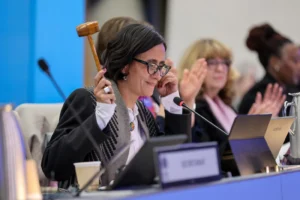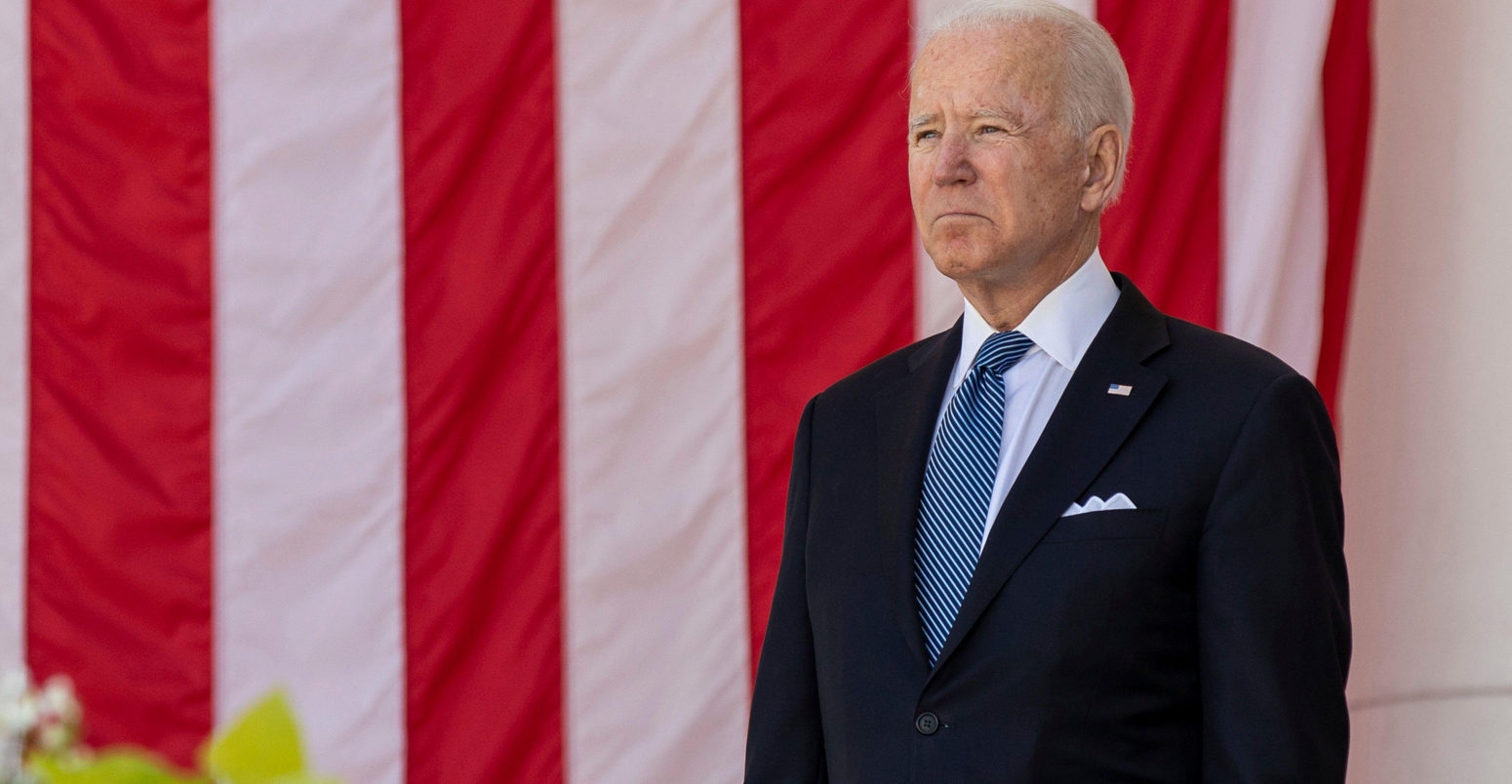
Analysis: US falling $32bn short on ‘fair share’ of $100bn climate-finance goal
Multiple Authors
11.07.22Multiple Authors
07.11.2022 | 6:00amThe US should be paying nearly $40bn towards the $100bn climate-finance target, new Carbon Brief analysis shows. This is $32bn more than the estimated $8bn it actually gave in 2020.
Other laggards include the UK, Canada and Australia, which all made smaller financial contributions to the internationally agreed target than their shares of historical emissions.
The analysis compares national shares of historical emissions with proportionate contributions to the $100bn climate finance target. Developed countries agreed at the COP15 climate summit in 2009 to deliver this funding by 2020.
The US, for example, is responsible for 52% of the historical emissions added to the atmosphere by Annex II countries. This is the list of “developed” or “industrialised” nations legally obliged to give climate finance under the terms of the UN climate convention.
If the US were to have paid an equivalent “fair share” of the $100bn climate finance target then, after accounting for private-finance contributions, it should have given $39.9bn.
In reality, it only gave $7.6bn (19% of its fair share) in 2020, the most recent year for which data is available.
Similarly, Canada gave 37% of its fair share and was $3.3bn short, while Australia gave 38% of its fair share and fell short by $1.7bn. The UK gave 76% of its fair share, falling short by $1.4bn.
Germany, France and Japan gave proportionally more than their contribution to historical warming. Unlike others, however, much of their finance is in the form of loans rather than grants.
Fair shares
Developed countries at UN climate negotiations agreed in 1992 to provide “new and additional financial resources” to help developing countries tackle climate change.
This was based on the relatively wealthy “Annex II” nations having both greater capacity to cope with the challenges ahead and greater historical responsibility for causing climate change.
(Inclusion in Annex II was based on membership of the Organisation for Economic Co-operation and Development (OECD) at the time, including western European nations, the US, Canada, Australia, New Zealand and Japan. As such, it does not include large economies such as China.)
At that point they were responsible for 46% of cumulative historical carbon dioxide (CO2) emissions from fossil fuels, industrial processes, cement, land use, land use change and forestry. As of 2020, they were still responsible for 40% of the global total.
Their climate-finance obligation was given a tighter focus in 2009, when they said they would “mobilise $100bn per year by 2020” so as to “address the needs of developing countries”. But they have failed to meet this goal and are not expecting to do so until 2023.
In 2020, only $83bn of climate finance was given, including $60bn in bilateral country-to-country aid and contributions via development banks, plus $23bn from climate funds and private sources.
There are no official numbers for each countries’ contribution to this $83bn total. However, Carbon Brief has estimated their contributions (see methodology below). These contributions can be compared with each nation’s share of historical emissions, previously calculated by Carbon Brief.
This comparison shows which countries contributed a “fair share” of the $100bn target. That is, a contribution in proportion with their share of Annex II historical emissions.
The chart below shows the results of this comparison. The vertical line at zero marks each countries’ fair share of the $100bn target. Negative numbers (red) indicate countries that fell short of their fair share in 2020 and positive numbers (blue) show those that gave more.
Major economies including the US, Canada, Australia and the UK collectively fell tens of billions of dollars short of their fair shares in 2020. In contrast, Germany, France and Japan each gave billions of dollars more than their fair share of the total.
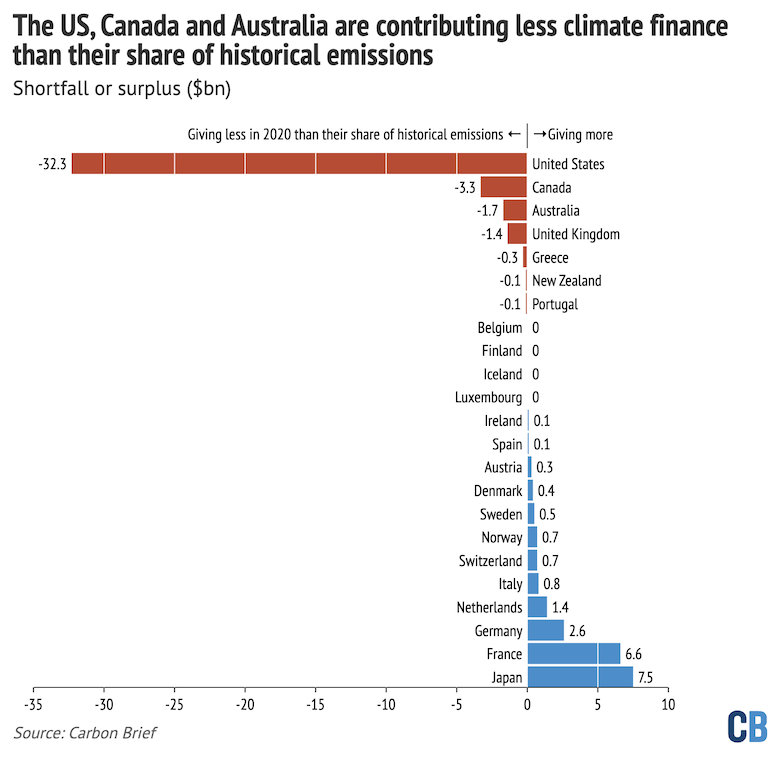
The large shortfall for the US is explained partly by its status as by far the world’s biggest historical emitter. It is responsible for around a fifth of the CO2 emissions that have been released, roughly double the contribution of China, which is in second place.
Most recently, following a pledge by president Joe Biden to contribute $11.4bn a year by 2024, the US Congress approved just $1bn in climate finance earlier this year.
The chart below shows climate-finance contributions in 2020 as a percentage of each country’s fair share of the $100bn target. For example, Finland met 100% of its fair share. As before, countries giving less than their fair share are coloured red and those giving more are blue.
Once again, the largest shortfall is for the US, whose $7.6bn contribution amounted to just 19% of its $40bn fair share. In contrast, Switzerland’s $1bn contribution was 436% of its fair share.
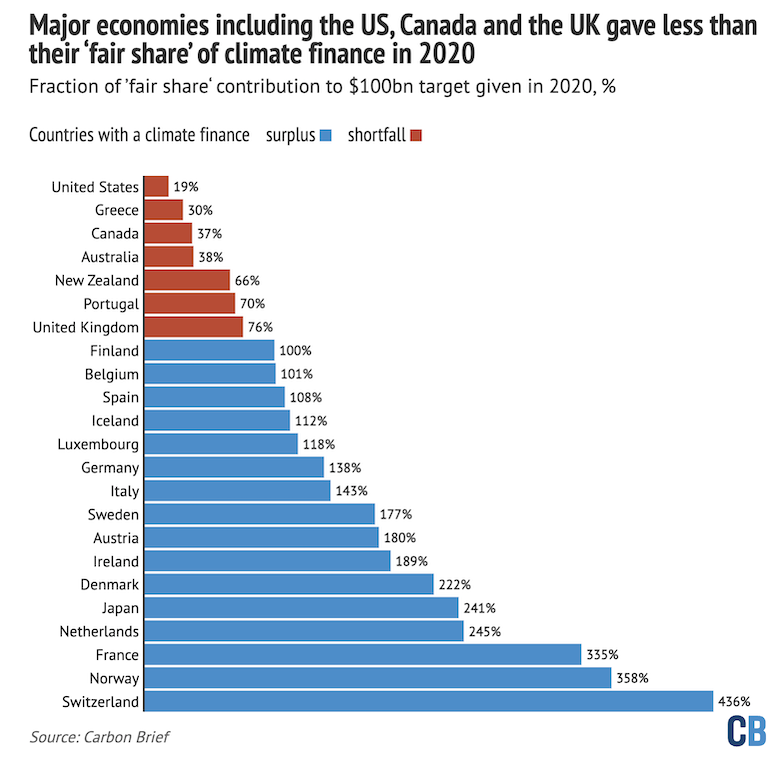
While some countries have given more than their fair share of the $100bn target, their apparent generosity is clouded by their preference for giving climate finance as loans rather than grants.
Indeed, a push for climate finance to be delivered as grants rather than loans is a key ask from many developing countries at the COP27 climate talks.
The first chart above shows that Germany, France and Japan are the countries most in “surplus” against their fair shares of climate finance. Yet these same three countries are, by some distance, the most likely to give climate finance as loans, rather than grants.
The share of each country’s climate finance given as loans is shown in the chart below, covering the period 2012-2020. As before, countries less than their fair share of the $100bn target are shaded red and those giving more are shaded blue.
Germany, France and Japan are clear outliers, giving 45%, 75% and 86% of their finance as loans, respectively. The next highest user of loans is Austria, at just 24%.
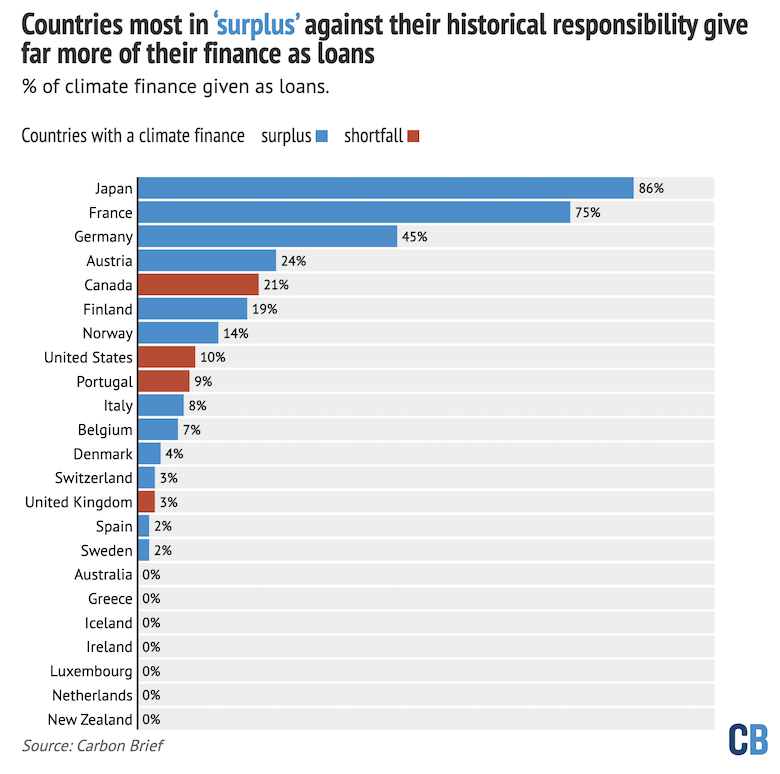
Methodology
This analysis compares climate-finance contributions with contributions to cumulative historical emissions. It focuses on the “Annex II” countries, including western Europe, the US, Canada, Australia, New Zealand and Japan, as well as the EU. These parties are obliged under the UN regime to provide climate finance to developing countries.
Data on climate finance comes from the OECD, with elements of the methodology based on efforts by the World Resources Institute (WRI) and Oxfam. The historical emissions figures come from Carbon Brief’s previous analysis.
The OECD has produced a report that shows progress by “developed” Annex II countries towards the $100bn target, which includes numbers up to 2020 – the deadline for the target.
However, this report does not include a country-by-country breakdown of where climate finance is coming from. Its inputs are based on figures submitted to the UNFCCC by developed countries in their biennial reports, which are only publicly available through to 2018.
The OECD also has separate data on “climate-related bilateral development finance”, which includes a country-by-country breakdown of bilateral climate finance figures. This data is slightly different from the figures submitted to the UNFCCC, but is available until 2020.
Carbon Brief has used this OECD data for all Annex II countries in the year 2020. Finance marked by the OECD as having a “principal” climate purpose is counted in full. Contributions described as having a “significant” climate purpose are discounted by 50%, to reflect the fact that they are also supporting other aims. This is based on a methodology previously used by Oxfam.
Bilateral finance flows alone do not provide an accurate picture of the state of climate finance, which also flows via multilateral development banks (MDBs). For some nations, notably the US, contributions channelled via MDBs constitute major chunks of their overall climate finance.
However, the publicly available OECD datasets do not divide up MDB finance flows according to the countries that contributed the money. WRI has previously estimated how much of the climate finance from MDBs can be attributed to each country, looking at spending during 2013-2018.
For this analysis, Carbon Brief replicated WRI’s methodology for the year 2020, based on capital shares in MDBs by Annex II countries in 2018. (These shares tend to remain fairly constant, so the 2018 values serve as a reasonable proxy for shares in 2020.)
The WRI methodology was also used to assign EU climate finance to member states and the UK, based on contributions to the overall EU budget. While the UK formally left the EU on 31 January 2020, it participated in the EU budget “largely as if a member state” until the end of the year.
The resulting numbers were combined with the bilateral climate finance numbers for each country to give a total figure for the year 2020.
Carbon Brief has counted “other multilateral finance” as the difference between MDB totals estimated using WRI’s methodology and the “multilateral public” figures in the latest OECD report. This includes finance coming from multilateral funds such as the Green Climate Fund.
The OECD uses a more complex methodology when it divides up MDB finance among countries. It gives developed countries with stronger credit ratings larger shares of MDB finance, an approach that is controversial among developing countries.
Finally, Carbon Brief used OECD’s figures for export credits and private finance mobilised towards the $100bn target. These have not been assigned to individual countries.
The historical emissions data covers CO2 output during the years 1850-2020 from fossil fuels, cement, land use, land use change and forestry. Annex II countries are responsible for 40% of cumulative global emissions in this period. The US alone accounts for more than 20%.
-
Analysis: US falling $32bn short on ‘fair share’ of $100bn climate-finance goal





